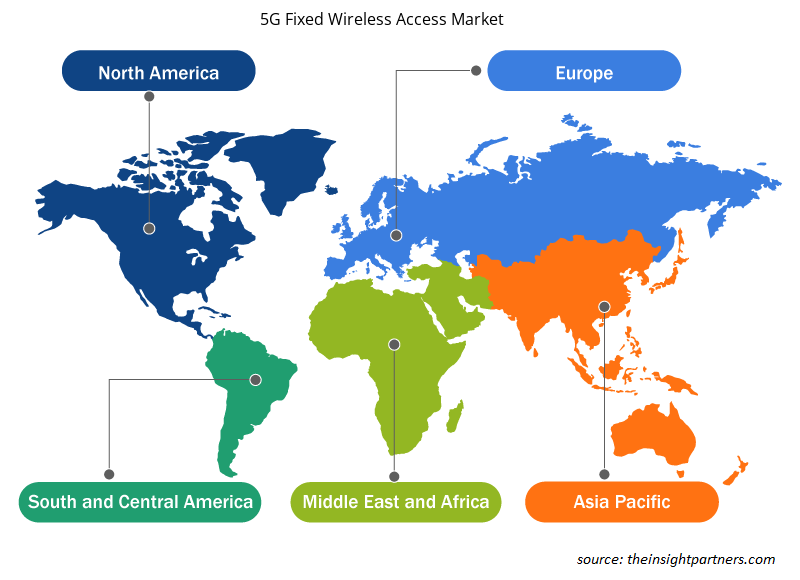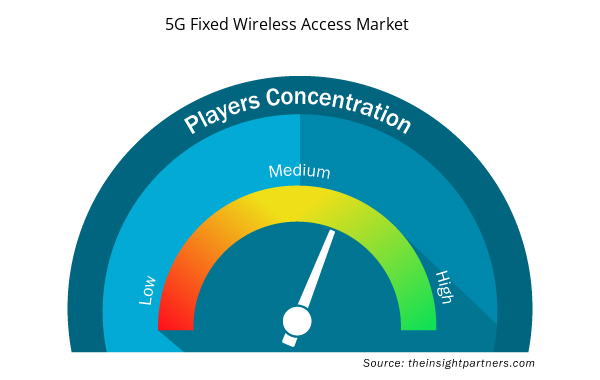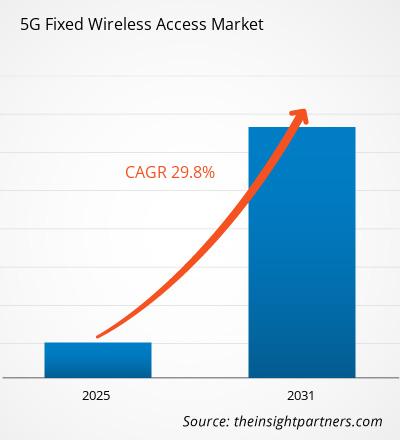Si prevede che il mercato dell'accesso wireless fisso 5G registrerà un CAGR del 29,8% dal 2023 al 2031, con una dimensione di mercato in espansione da XX milioni di dollari nel 2023 a XX milioni di dollari entro il 2031.
Il report è segmentato per Offerta (Hardware e Servizi), Applicazione (Residenziale, Commerciale e Industriale), Frequenza Operativa (SUB-6 GHZ, 24 GHZ-39 GHZ e OLTRE 39 GHZ). L'analisi globale è ulteriormente suddivisa a livello regionale e nei principali Paesi. Il report offre il valore in USD per l'analisi e i segmenti di cui sopra
Scopo del rapporto
Il report 5G Fixed Wireless Access Market di The Insight Partners mira a descrivere il panorama attuale e la crescita futura, i principali fattori trainanti, le sfide e le opportunità. Ciò fornirà spunti a vari stakeholder aziendali, come:
- Fornitori/produttori di tecnologia: per comprendere le dinamiche di mercato in evoluzione e conoscere le potenziali opportunità di crescita, consentendo loro di prendere decisioni strategiche informate.
- Investitori: condurre un'analisi completa delle tendenze relative al tasso di crescita del mercato, alle proiezioni finanziarie del mercato e alle opportunità esistenti lungo la catena del valore.
- Enti di regolamentazione: regolamentano le politiche e le attività di controllo sul mercato allo scopo di ridurre al minimo gli abusi, preservare la fiducia degli investitori e sostenere l'integrità e la stabilità del mercato.
Segmentazione del mercato dell'accesso wireless fisso 5G
Offerta
- Hardware e servizi
Applicazione
- Residenziale
- Commerciale
- Industriale
Frequenza operativa
- SOTTO-6 GHZ
- 24-39 GHz
- OLTRE 39 GHZ
Geografia
- America del Nord
- Europa
- Asia-Pacifico
- America del Sud e Centro
- Medio Oriente e Africa
Geografia
- America del Nord
- Europa
- Asia-Pacifico
- America del Sud e Centro
- Medio Oriente e Africa
Personalizza questo report in base alle tue esigenze
Riceverai la personalizzazione gratuita di qualsiasi report, comprese parti di questo report, o analisi a livello nazionale, pacchetto dati Excel, oltre a usufruire di grandi offerte e sconti per start-up e università
- Scopri le principali tendenze di mercato in questo rapporto.Questo campione GRATUITO includerà analisi di dati che spaziano dalle tendenze di mercato alle stime e alle previsioni.
Driver di crescita del mercato dell'accesso wireless fisso 5G
- Soluzione di connettività dell'ultimo miglio: 5G FWA risolve la sfida più importante dell'"ultimo miglio" rendendo Internet ad alta velocità immediatamente disponibile agli utenti finali tramite linea fissa, eliminando così le costose installazioni di cavi in fibra. È molto conveniente laddove la posa di infrastrutture fisiche è costosa o impossibile, riducendo sostanzialmente sia i tempi che i costi di distribuzione.
- Domanda crescente di Internet ad alta velocità: la crescita esplosiva del lavoro da remoto, dello streaming video, dei giochi online e dei dispositivi IoT ha dato origine a una domanda di Internet ad alta velocità su una scala senza precedenti. Qui, il 5G FWA può soddisfare questa domanda fornendo velocità simili alla fibra in modalità wireless per supportare più dispositivi e applicazioni ad alta intensità di larghezza di banda in parallelo.
- Progressi tecnologici: ad esempio, Massive MIMO e beamforming sono le tecnologie che consentirebbero di migliorare le prestazioni del 5G FWA, aumentando così la velocità dei dati con una migliore penetrazione, ottimizzando quindi l'utilizzo dello spettro.
Tendenze future del mercato dell'accesso wireless fisso 5G
- Evoluzione del modello di business: l'evoluzione del modello di business nel 5G FWA è di moda attraverso opzioni di abbonamento flessibili con modelli pay-as-you-grow e pacchetti aziendali personalizzati. L'operatore sta abbracciando nuovi modelli di business; si sta passando dai tradizionali contratti fissi a soluzioni ibride e servizi in bundle con piani mobili, massimizzando i flussi di entrate e la soddisfazione del cliente.
- Connettività per aree rurali e remote: una grande opportunità per il mercato 5G FWA risiede nel fornire accesso a Internet ad aree rurali e remote che sono tradizionalmente poco servite da servizi di banda larga in fibra ottica o via cavo. Utilizzando reti 5G per connessioni wireless, gli operatori di telecomunicazioni possono distribuire rapidamente Internet ad alta velocità in queste regioni senza gli alti costi e le sfide logistiche associate alla posa di infrastrutture cablate tradizionali. Ciò potrebbe migliorare significativamente l'accesso a Internet, l'istruzione, l'assistenza sanitaria e lo sviluppo economico nelle comunità rurali.
Opportunità di mercato per l'accesso wireless fisso 5G
- Implementazione del Multi-Access Edge Computing (MEC) per prestazioni migliorate: una tendenza crescente nel mercato 5G FWA è l'integrazione del Multi-Access Edge Computing (MEC) con reti wireless per migliorare le prestazioni del Fixed Wireless Access. MEC avvicina l'elaborazione e l'archiviazione all'utente finale, riducendo la latenza e migliorando l'esperienza utente complessiva. Sfruttando l'edge computing, le reti 5G FWA possono gestire grandi volumi di dati in modo più efficiente, abilitando applicazioni in tempo reale come streaming video, giochi online e telemedicina con un ritardo minimo. Questa tendenza sta aumentando l'attrattiva del 5G FWA sia per i consumatori che per le aziende.
- Iniziative per le smart city: 5G FWA è uno degli spettri per le applicazioni smart city, che fornisce connettività ad alta velocità e bassa latenza per sensori IoT, sistemi di sorveglianza, gestione del traffico e servizi pubblici con costi di distribuzione infrastrutturale ridotti. Pertanto consentirà la raccolta e l'analisi dei dati in tempo reale affinché le città siano più efficienti e reattive.
Approfondimenti regionali sul mercato dell'accesso wireless fisso 5G
Le tendenze regionali e i fattori che influenzano il mercato dell'accesso wireless fisso 5G durante il periodo di previsione sono stati ampiamente spiegati dagli analisti di Insight Partners. Questa sezione discute anche i segmenti e la geografia del mercato dell'accesso wireless fisso 5G in Nord America, Europa, Asia Pacifico, Medio Oriente e Africa e America meridionale e centrale.

- Ottieni i dati specifici regionali per il mercato dell'accesso wireless fisso 5G
Ambito del rapporto di mercato sull'accesso wireless fisso 5G
| Attributo del report | Dettagli |
|---|---|
| Dimensioni del mercato nel 2023 | XX milioni di dollari USA |
| Dimensioni del mercato entro il 2031 | XX milioni di dollari USA |
| CAGR globale (2023-2031) | 29,8% |
| Dati storici | 2021-2022 |
| Periodo di previsione | 2024-2031 |
| Segmenti coperti | Offrendo
|
| Regioni e Paesi coperti | America del Nord
|
| Leader di mercato e profili aziendali chiave |
|
Densità degli attori del mercato dell'accesso wireless fisso 5G: comprendere il suo impatto sulle dinamiche aziendali
Il mercato del mercato dell'accesso wireless fisso 5G sta crescendo rapidamente, spinto dalla crescente domanda degli utenti finali dovuta a fattori quali l'evoluzione delle preferenze dei consumatori, i progressi tecnologici e una maggiore consapevolezza dei vantaggi del prodotto. Con l'aumento della domanda, le aziende stanno ampliando le loro offerte, innovando per soddisfare le esigenze dei consumatori e capitalizzando sulle tendenze emergenti, il che alimenta ulteriormente la crescita del mercato.
La densità degli operatori di mercato si riferisce alla distribuzione di aziende o società che operano in un particolare mercato o settore. Indica quanti concorrenti (operatori di mercato) sono presenti in un dato spazio di mercato in relazione alle sue dimensioni o al valore di mercato totale.
Le principali aziende che operano nel mercato dell'accesso wireless fisso 5G sono:
- Azienda
- Cisco
- Società Nokia
- Società controllata da Huawei
- Qualcomm Technologies, Inc.
Disclaimer : le aziende elencate sopra non sono classificate secondo un ordine particolare.

- Ottieni una panoramica dei principali attori del mercato dell'accesso wireless fisso 5G
Punti chiave di vendita
- Copertura completa: il rapporto copre in modo completo l'analisi di prodotti, servizi, tipologie e utenti finali del mercato dell'accesso wireless fisso 5G, fornendo una panoramica olistica.
- Analisi degli esperti: il rapporto è compilato sulla base della conoscenza approfondita di esperti e analisti del settore.
- Informazioni aggiornate: il rapporto garantisce la pertinenza aziendale grazie alla copertura di informazioni recenti e tendenze nei dati.
- Opzioni di personalizzazione: questo report può essere personalizzato per soddisfare le esigenze specifiche del cliente e adattarsi in modo appropriato alle strategie aziendali.
Il rapporto di ricerca sul mercato dell'accesso wireless fisso 5G può, quindi, aiutare a guidare il percorso di decodifica e comprensione dello scenario del settore e delle prospettive di crescita. Sebbene possano esserci alcune preoccupazioni valide, i vantaggi complessivi di questo rapporto tendono a superare gli svantaggi.
- Analisi storica (2 anni), anno base, previsione (7 anni) con CAGR
- Analisi PEST e SWOT
- Valore/volume delle dimensioni del mercato - Globale, regionale, nazionale
- Industria e panorama competitivo
- Set di dati Excel



Report Coverage
Revenue forecast, Company Analysis, Industry landscape, Growth factors, and Trends

Segment Covered
This text is related
to segments covered.

Regional Scope
North America, Europe, Asia Pacific, Middle East & Africa, South & Central America

Country Scope
This text is related
to country scope.
Domande frequenti
Business Model Evolution
The report can be delivered in PDF/PPT format; we can also share excel dataset based on the request
Some of the customization options available based on the request are an additional 3-5 company profiles and country-specific analysis of 3-5 countries of your choice. Customizations are to be requested/discussed before making final order confirmation# as our team would review the same and check the feasibility
Last-Mile Connectivity Solution, Growing Demand for High-Speed Internet, Technological Advancements
The 5G Fixed Wireless Access Market is estimated to witness a CAGR of 29.8% from 2023 to 2031
Trends and growth analysis reports related to Electronics and Semiconductor : READ MORE..
The List of Companies
1. Cohere Technologies, Inc.
2. Cisco
3. Nokia Corporation
4. Huawei Technologies Co., Ltd.
5. Qualcomm Technologies, Inc.
6. Samsung Electronics Co., Ltd. (Samsung)
7. Verizon Communications Inc.
8. Mimosa Networks, Inc. (Airspan Networks Inc.)
9. Siklu Communication
10. Telefonaktiebolaget LM Ericsson
The Insight Partners performs research in 4 major stages: Data Collection & Secondary Research, Primary Research, Data Analysis and Data Triangulation & Final Review.
- Data Collection and Secondary Research:
As a market research and consulting firm operating from a decade, we have published and advised several client across the globe. First step for any study will start with an assessment of currently available data and insights from existing reports. Further, historical and current market information is collected from Investor Presentations, Annual Reports, SEC Filings, etc., and other information related to company’s performance and market positioning are gathered from Paid Databases (Factiva, Hoovers, and Reuters) and various other publications available in public domain.
Several associations trade associates, technical forums, institutes, societies and organization are accessed to gain technical as well as market related insights through their publications such as research papers, blogs and press releases related to the studies are referred to get cues about the market. Further, white papers, journals, magazines, and other news articles published in last 3 years are scrutinized and analyzed to understand the current market trends.
- Primary Research:
The primarily interview analysis comprise of data obtained from industry participants interview and answers to survey questions gathered by in-house primary team.
For primary research, interviews are conducted with industry experts/CEOs/Marketing Managers/VPs/Subject Matter Experts from both demand and supply side to get a 360-degree view of the market. The primary team conducts several interviews based on the complexity of the markets to understand the various market trends and dynamics which makes research more credible and precise.
A typical research interview fulfils the following functions:
- Provides first-hand information on the market size, market trends, growth trends, competitive landscape, and outlook
- Validates and strengthens in-house secondary research findings
- Develops the analysis team’s expertise and market understanding
Primary research involves email interactions and telephone interviews for each market, category, segment, and sub-segment across geographies. The participants who typically take part in such a process include, but are not limited to:
- Industry participants: VPs, business development managers, market intelligence managers and national sales managers
- Outside experts: Valuation experts, research analysts and key opinion leaders specializing in the electronics and semiconductor industry.
Below is the breakup of our primary respondents by company, designation, and region:

Once we receive the confirmation from primary research sources or primary respondents, we finalize the base year market estimation and forecast the data as per the macroeconomic and microeconomic factors assessed during data collection.
- Data Analysis:
Once data is validated through both secondary as well as primary respondents, we finalize the market estimations by hypothesis formulation and factor analysis at regional and country level.
- Macro-Economic Factor Analysis:
We analyse macroeconomic indicators such the gross domestic product (GDP), increase in the demand for goods and services across industries, technological advancement, regional economic growth, governmental policies, the influence of COVID-19, PEST analysis, and other aspects. This analysis aids in setting benchmarks for various nations/regions and approximating market splits. Additionally, the general trend of the aforementioned components aid in determining the market's development possibilities.
- Country Level Data:
Various factors that are especially aligned to the country are taken into account to determine the market size for a certain area and country, including the presence of vendors, such as headquarters and offices, the country's GDP, demand patterns, and industry growth. To comprehend the market dynamics for the nation, a number of growth variables, inhibitors, application areas, and current market trends are researched. The aforementioned elements aid in determining the country's overall market's growth potential.
- Company Profile:
The “Table of Contents” is formulated by listing and analyzing more than 25 - 30 companies operating in the market ecosystem across geographies. However, we profile only 10 companies as a standard practice in our syndicate reports. These 10 companies comprise leading, emerging, and regional players. Nonetheless, our analysis is not restricted to the 10 listed companies, we also analyze other companies present in the market to develop a holistic view and understand the prevailing trends. The “Company Profiles” section in the report covers key facts, business description, products & services, financial information, SWOT analysis, and key developments. The financial information presented is extracted from the annual reports and official documents of the publicly listed companies. Upon collecting the information for the sections of respective companies, we verify them via various primary sources and then compile the data in respective company profiles. The company level information helps us in deriving the base number as well as in forecasting the market size.
- Developing Base Number:
Aggregation of sales statistics (2020-2022) and macro-economic factor, and other secondary and primary research insights are utilized to arrive at base number and related market shares for 2022. The data gaps are identified in this step and relevant market data is analyzed, collected from paid primary interviews or databases. On finalizing the base year market size, forecasts are developed on the basis of macro-economic, industry and market growth factors and company level analysis.
- Data Triangulation and Final Review:
The market findings and base year market size calculations are validated from supply as well as demand side. Demand side validations are based on macro-economic factor analysis and benchmarks for respective regions and countries. In case of supply side validations, revenues of major companies are estimated (in case not available) based on industry benchmark, approximate number of employees, product portfolio, and primary interviews revenues are gathered. Further revenue from target product/service segment is assessed to avoid overshooting of market statistics. In case of heavy deviations between supply and demand side values, all thes steps are repeated to achieve synchronization.
We follow an iterative model, wherein we share our research findings with Subject Matter Experts (SME’s) and Key Opinion Leaders (KOLs) until consensus view of the market is not formulated – this model negates any drastic deviation in the opinions of experts. Only validated and universally acceptable research findings are quoted in our reports.
We have important check points that we use to validate our research findings – which we call – data triangulation, where we validate the information, we generate from secondary sources with primary interviews and then we re-validate with our internal data bases and Subject matter experts. This comprehensive model enables us to deliver high quality, reliable data in shortest possible time.


 Ottieni un campione gratuito per questo repot
Ottieni un campione gratuito per questo repot